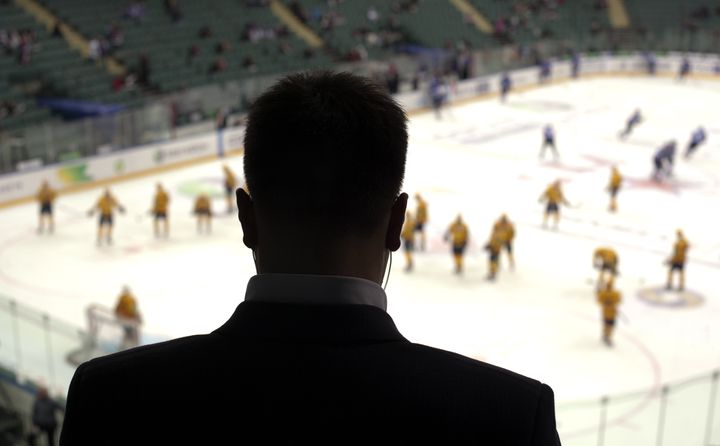
One of the things I look at when I observe officiating teams is how they handle transitions. This is every bit as important to good officiating work as puck support on the forecheck or backcheck is to playing winning hockey on the ice. Support your teammates and be mindful of your positioning.
With that in mind, here are a few of my expectations when I observe and review officiating teams. What I want to see is good positioning and sound judgement.
Good Positioning In Transition
When the play moves out of the defensive zone, the back referee will hustle to reach the blue line to provide support the the front referee.
When a player releases a clearing pass up the ice, the back referee will stay focused on the player who released the puck to look for a late or high hit. Remember, we need to penalize players who are "head hunting."
As the front referee who is skating backwards into the zone, you must focus on the play coming towards you and make sure that the skilled players are not impeded by their opponent. As officials, we should reward the players who skate and demonstrate skill. We should not reward players who fail to move their feet or, worse, embellish. We should penalize the players who prevent opponents from demonstrating their skating and puck-moving skills.
Sound Judgment
In past years, officials were trained to raise their penalty-scoping antenna when a player's stick was parallel with the ice or a hand came off the stick. This has been refined somewhat in recent years. In the case of the collegiate officials I direct in the ECAC, this must be done in accordance with the requirements of the NCAA Standard of Play. In the case of the NHL, KHL and other leagues, it is in accordance with the directives of those leagues.
With the idea of rewarding the skilled player in mind, any time a player's action negatively impacts an opposing players ability to skate, stickhandle, or shoot, the offending player needs to be penalized.
An example of this is when a forward is skating through the neutral zone and an opponent hooks his top hand off his stick causing him to slow down or change his lane. We need to make the call on these types of plays.
The coaches on the benches may holler about a "ticky-tack call." The TV announcers may gripe. The home fans may boo if the call goes against their team. But these sorts of plays are penalties.
Another point: Just because a player does not go down, does not mean that a penalty should be ignored. The message we as officials need to give the players and coaches is to stay on your feet and don't go down. Reward the player who tries to fight through the illegal check.
It has been said -- and I agree with this -- that letting too many penalties go when fouled players stay up can have the unintended effect of sending a message that going down is the way to get a call. We don't want that.
Likewise, we should not reward players who stop skating. If a player gets grabbed, restrained or pinned to the wall and stops trying to skate -- in the hopes of drawing a call for his team -- do not reward the laziness with a power play.
With every fiber of my being as an official and former player, I detest diving and embellishment. As an officiating supervisor, I hate seeing divers get rewarded with a power play for their team.
Personally, in an ideal world for officiating power, I would prefer if the widely accepted standard was to give a diver a 10-minute misconduct rather than to give offsetting minor penalties to each team. That would be a real deterrent, in my opinion, especially to the skill players who are prone to embellishment/diving.
Their "gravity problem" would be solved in a hurry if they risked a 10-minute misconduct for embellishing to draw calls. Coaches would also be much more likely to get on their own skill players not to dive if they took the risk of a misconduct rather than a minor.
In reality, that's not what the current rulebook or the league directives say to do to keep the players honest. The various leagues' accepted standards are what need to be followed in actual practice.
So when should the offsetting minors be given and when should only the diver be given a minor? If the hook or hold is there -- and the player who was hooked or held could receive an Oscar nomination for the acting performance -- then assess the restraining foul and the embellishment to put the teams at 4-on-4. If the hook is not there, and the player will still receive an Academy Award consideration, then call the diving penalty alone.
********
Paul Stewart holds the distinction of being the first U.S.-born citizen to make it to the NHL as both a player and referee. On March 15, 2003, he became the first American-born referee to officiate in 1,000 NHL games.
Today, Stewart is an officiating and league discipline consultant for the Kontinental Hockey League (KHL) and serves as director of hockey officiating for the ECAC.
The longtime referee heads Officiating by Stewart, a consulting, training and evaluation service for officials. Stewart also maintains a busy schedule as a public speaker, fund raiser and master-of-ceremonies for a host of private, corporate and public events. As a non-hockey venture, he is the owner of Lest We Forget.
Stewart's writings can also be found on HockeyBuzz.com every Monday, Tuesday, Thursday and Friday. He is currently working with a co-author in writing an autobiography.